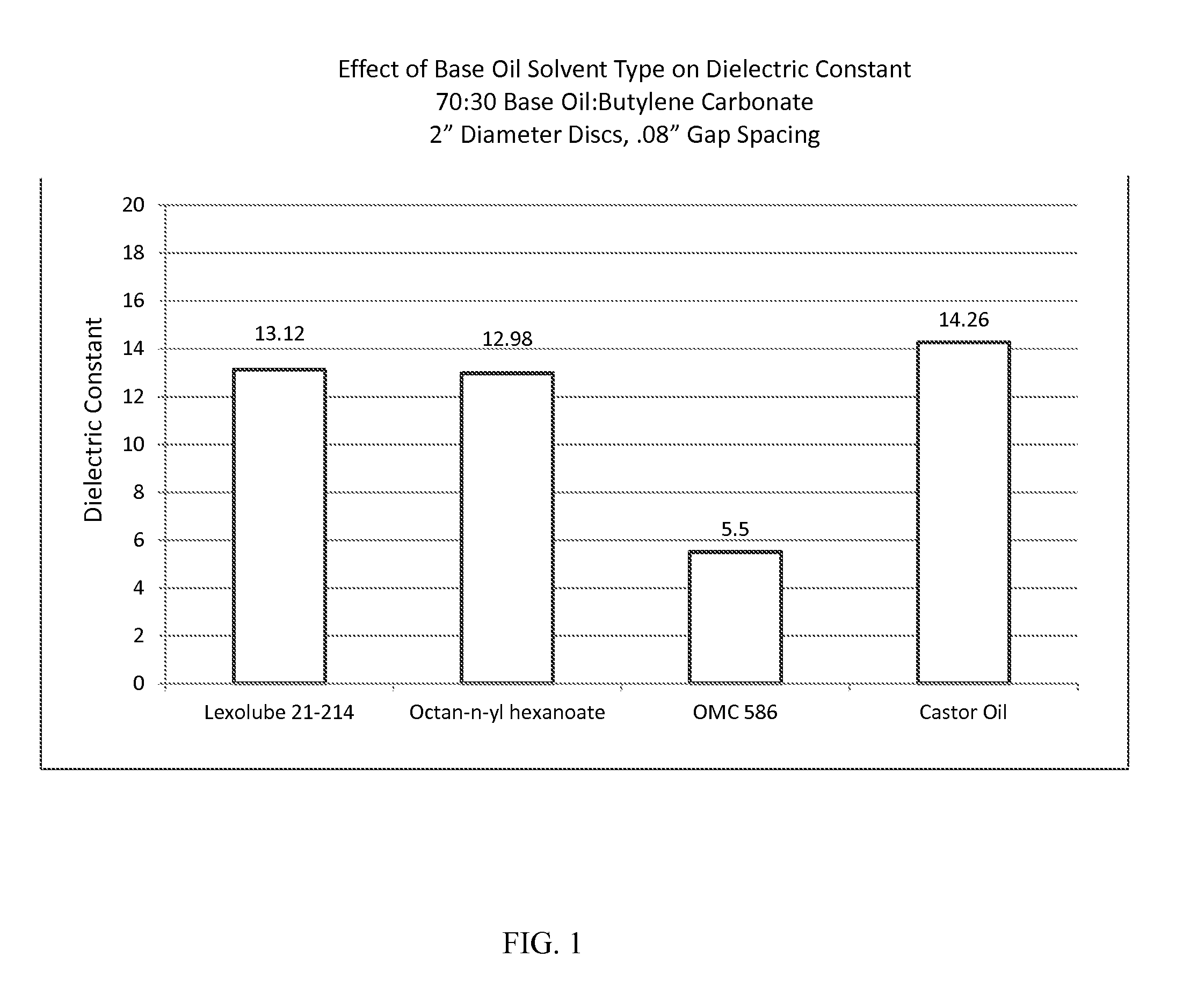Pulse power drilling fluid and methods of use
a technology of pulse power and drilling fluid, which is applied in the direction of drilling machines and methods, drilling accessories, chemistry apparatus and processes, etc., can solve the problems of high dielectric strength and low conductivity, unsuitable base oil for pulse power applications, and fractured rock or hard substrate pressure,
- Summary
- Abstract
- Description
- Claims
- Application Information
AI Technical Summary
Benefits of technology
Problems solved by technology
Method used
Image
Examples
example 1
Evaluation of Comparative Drilling Fluids Formulated with Castor Oil—Rheological and Fluid Loss Properties
[0096]Castor oil is a triglyceride in which 90% of the fatty acid chains are ricinoleic acid. Oleic and linoleic acids are other components. Castor oil has a viscosity of 259 to 325 cSt at 40° C., a density of 0.96 g / cc, a flash point of 282° C. and a pour point of −20 F. Castor oil has a dielectric constant of 4.45 at 22° C. It has a dielectric strength of greater than 300 kV / cm.
[0097]An 80 / 20 v / v castor oil / butylene carbonate solution has a relative permittivity (dielectric constant) of 15. At greater than 32% butylene carbonate, the butylene carbonate is not soluble in the castor oil and the mixture separates when standing at room temperature. The 80 / 20 solution absorbs up to 2,000 ppm of water without affecting the dielectric properties. This solution has a kinematic viscosity of 250 cSt at 21° C. (70° F.) and a kinematic viscosity of 100 cSt at 40 C (104° F.). The solution ...
example 2
Evaluation of Comparative Drilling Fluids Formulated with Castor Oil—Dielectric Strength
[0104]In our experience, it is necessary for a pulse power drilling fluid according to the exemplified embodiments to exhibit a minimum dielectric strength of 300 kV / cm, which maximizes performance in the pulse power drilling environment. In order to determine the dielectric strength of a drilling fluid, the breakdown voltage can be evaluated, e.g., using commercially available dielectric strength testers such as Megger Dielectric Tester (5 kV DC), Baur PGK50 (50 kV), Kleanoil HBVT Transformer Oil Dielectric Strength / Breakdown Voltage Tester, Hipotronics OC60D—A Oil Dielectric Tester (60 kV).
[0105]The dielectric constant of ethylene carbonate at 40° C. is about 90, the dielectric constant of propylene carbonate at 20° C. is about 64, and the dielectric constant of butylene carbonate at 20° C. is about 57.7. The dielectric constant of an 80 / 20 v / v solution of castor oil and butylene carbonate at 2...
example 3
Evaluation of Esters—Hydrolytic Stability
[0111]10 ml of the ester to be tested was mixed with 20 ml 5N NaOH, stirred 15 mins in a beaker on a hot plate at 85° C., then shaken for 5 minutes in a jar and allowed to sit overnight. The results indicate that there was significantly more hydrolytic degradation (as evidenced by the formation of a gel rather than remaining a liquid) of the base oil comprising PETROFREE® LV (2-ethyl 2-ethylhexanoate) than of the base oil comprising an isomeric mixture of internal isomers of octan-n-yl hexanoate. This embodiment of the isomeric mixture of monoesters corresponds to a mixture of mainly octan-2-yl hexanoate, octan-3-yl hexanoate, and octan-4-yl hexanoate with very little (i.e., 1-3%) octan-1-yl hexanoate.
PUM
 Login to View More
Login to View More Abstract
Description
Claims
Application Information
 Login to View More
Login to View More - R&D
- Intellectual Property
- Life Sciences
- Materials
- Tech Scout
- Unparalleled Data Quality
- Higher Quality Content
- 60% Fewer Hallucinations
Browse by: Latest US Patents, China's latest patents, Technical Efficacy Thesaurus, Application Domain, Technology Topic, Popular Technical Reports.
© 2025 PatSnap. All rights reserved.Legal|Privacy policy|Modern Slavery Act Transparency Statement|Sitemap|About US| Contact US: help@patsnap.com



